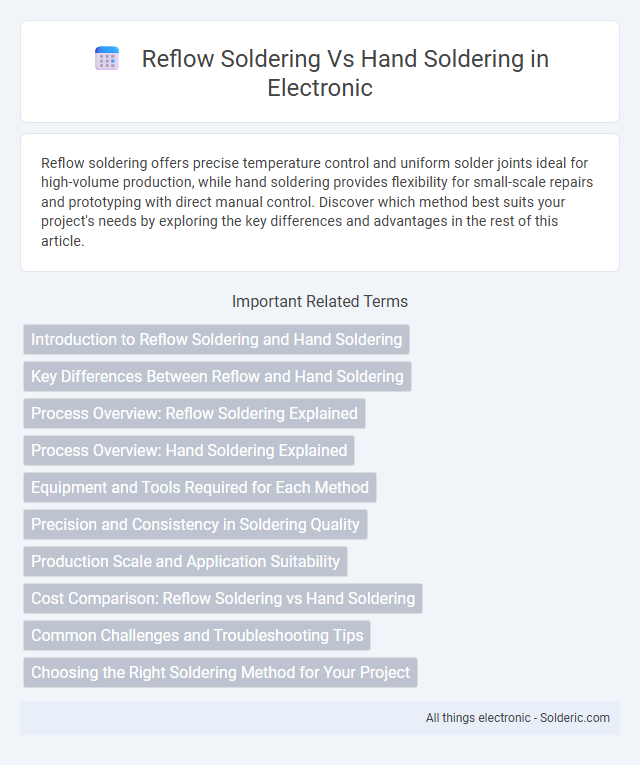Reflow soldering offers precise temperature control and uniform solder joints ideal for high-volume production, while hand soldering provides flexibility for small-scale repairs and prototyping with direct manual control. Discover which method best suits your project's needs by exploring the key differences and advantages in the rest of this article.
Comparison Table
| Feature | Reflow Soldering | Hand Soldering |
|---|---|---|
| Process | Automated heating of PCB with solder paste | Manual application of solder with a soldering iron |
| Speed | Fast, suitable for mass production | Slow, best for small quantities or repairs |
| Precision | Consistent, machine-controlled | Variable, depends on skill level |
| Component Types | SMD (Surface Mount Devices) primarily | Through-hole and some SMD components |
| Cost | High initial equipment cost, lower per unit cost | Low equipment cost, higher labor cost |
| Quality | High, reliable solder joints | Depends on operator skill, risk of cold joints |
| Applications | Mass PCB assembly, industrial manufacturing | Prototyping, repair, small batch production |
Introduction to Reflow Soldering and Hand Soldering
Reflow soldering utilizes precise temperature profiles to melt solder paste and create reliable, uniform joints on printed circuit boards (PCBs), making it ideal for mass production and surface-mount technology (SMT) components. Hand soldering involves manually applying solder with a soldering iron, providing flexibility and control for small-scale assembly, repairs, or prototypes, often essential in troubleshooting and fine-tuning electronics. Both techniques are critical in electronics manufacturing, with reflow soldering emphasizing efficiency and consistency while hand soldering prioritizes precision and adaptability.
Key Differences Between Reflow and Hand Soldering
Reflow soldering uses controlled heat profiles to uniformly melt solder paste on printed circuit boards, ensuring precise and consistent component placement, while hand soldering relies on manual application of solder with a soldering iron, making it more suited for small-scale or repair tasks. Reflow processes are highly efficient for mass production with better repeatability and reduced thermal stress on components, contrasting with the variable skill-dependent quality and slower pace of hand soldering. The automation and temperature control in reflow soldering minimize defects such as cold joints and bridging, which are more common in hand soldering due to human error.
Process Overview: Reflow Soldering Explained
Reflow soldering involves applying solder paste to PCB pads, placing components, and heating the assembly in a controlled oven to melt the solder and create secure electrical connections. The process offers precise temperature control through preheating, soaking, reflow, and cooling stages, ensuring uniform solder joints and minimizing thermal stress. Unlike hand soldering, which relies on manual application of heat and solder, reflow soldering provides consistent results suitable for high-volume manufacturing and complex surface-mount devices.
Process Overview: Hand Soldering Explained
Hand soldering involves manually heating the solder joint with a soldering iron to join electronic components to a PCB, providing precise control for small-scale or rework tasks. This process requires skilled operators to apply solder wire and heat simultaneously, ensuring proper wetting and reliable electrical connections. Unlike reflow soldering, hand soldering is labor-intensive and suited for prototypes or repairs rather than high-volume production.
Equipment and Tools Required for Each Method
Reflow soldering requires specialized equipment such as a reflow oven or infrared heater to evenly melt solder paste on circuit boards, ensuring precise and consistent solder joints. Hand soldering relies on basic tools like a soldering iron, solder wire, flux, and tweezers, allowing for detailed work and adjustments on individual components. Your choice between these methods impacts the equipment investment and suitability for high-volume manufacturing versus prototyping and repairs.
Precision and Consistency in Soldering Quality
Reflow soldering ensures high precision and consistency by using controlled temperature profiles that uniformly melt solder paste across all components, minimizing human error and variations. Hand soldering relies heavily on operator skill, often resulting in inconsistent solder joints and potential defects due to uneven heat application. Automated reflow processes are preferred in mass production for their repeatable quality and reduced risk of thermal damage compared to manual soldering methods.
Production Scale and Application Suitability
Reflow soldering excels in high-volume PCB assembly, providing consistent quality and faster production rates ideal for mass manufacturing. Hand soldering suits low-volume or prototype work where precision and flexibility are crucial, making it preferable for custom or small-scale electronics projects. Your choice depends on balancing production scale demands with the need for application-specific soldering precision.
Cost Comparison: Reflow Soldering vs Hand Soldering
Reflow soldering involves higher initial equipment costs due to the need for specialized ovens and precise temperature controls, but it significantly reduces per-unit labor expenses in mass production. Hand soldering has minimal startup costs, relying mainly on basic tools, but incurs higher labor costs and slower throughput, making it less cost-effective for large-scale manufacturing. For high-volume production, reflow soldering offers superior cost efficiency, whereas hand soldering remains economical for prototyping or small-batch assemblies.
Common Challenges and Troubleshooting Tips
Reflow soldering often faces challenges such as insufficient wetting, solder bridging, and tombstoning due to improper temperature profiles or PCB design. Hand soldering risks include cold joints, solder balls, and component damage caused by inconsistent heat application or poor technique. Troubleshooting these issues involves optimizing solder paste deposition, regulating heat ramps in reflow ovens, and using appropriate soldering iron temperatures with proper tip cleanliness and technique during manual soldering.
Choosing the Right Soldering Method for Your Project
Reflow soldering offers precise, consistent results ideal for high-volume or complex PCB assemblies, while hand soldering provides flexibility and cost-effectiveness for small-scale or repair projects. Your choice depends on factors like project size, component complexity, and production budget. Selecting the right soldering method ensures optimal efficiency and product quality tailored to your specific needs.
reflow soldering vs hand soldering Infographic

 solderic.com
solderic.com